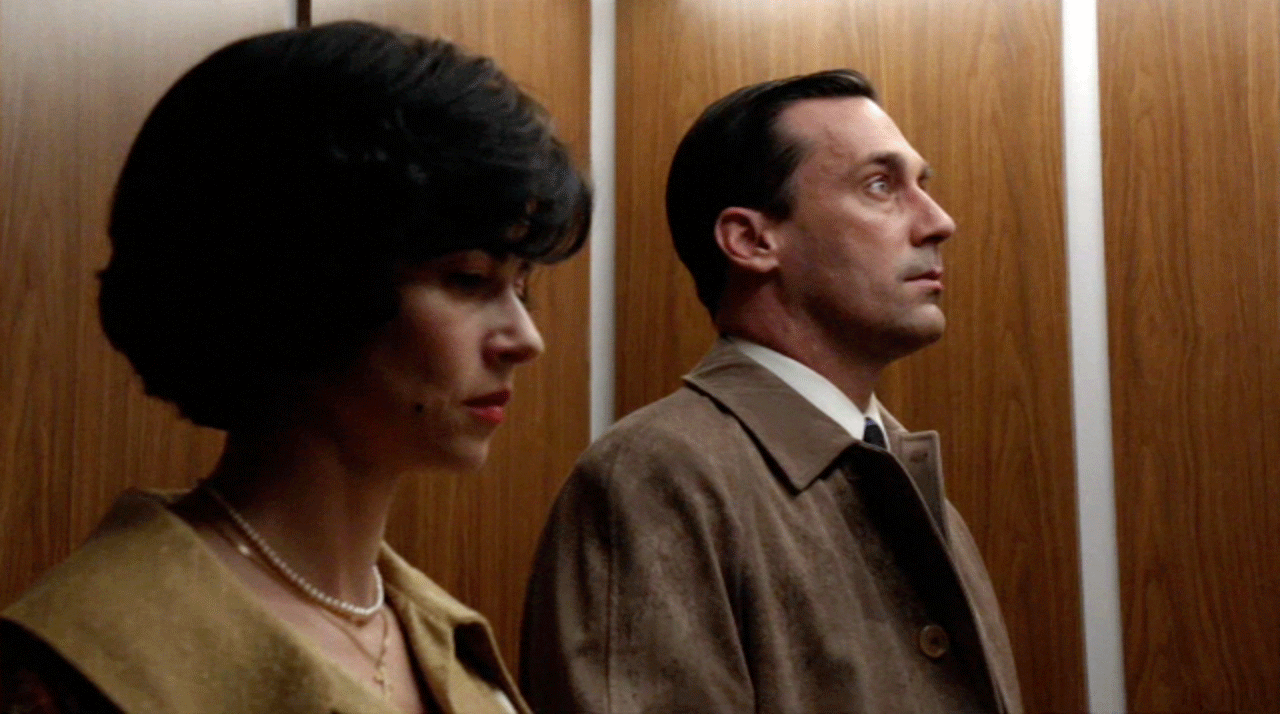
[The sixth in the Unit for Criticism's multi-authored series of posts on Season 6 of AMC's Mad Men, posted in collaboration with the publication ofMADMEN, MADWORLD: Sex, Politics, Style, andthe 1960s(Duke University Press, March 2013) Eds. Lauren M. E. Goodlad, Lilya Kaganovsky and Robert A. Rushing]
"The Pause That Refreshes"
Written by: Sean O'Sullivan (Ohio State University)
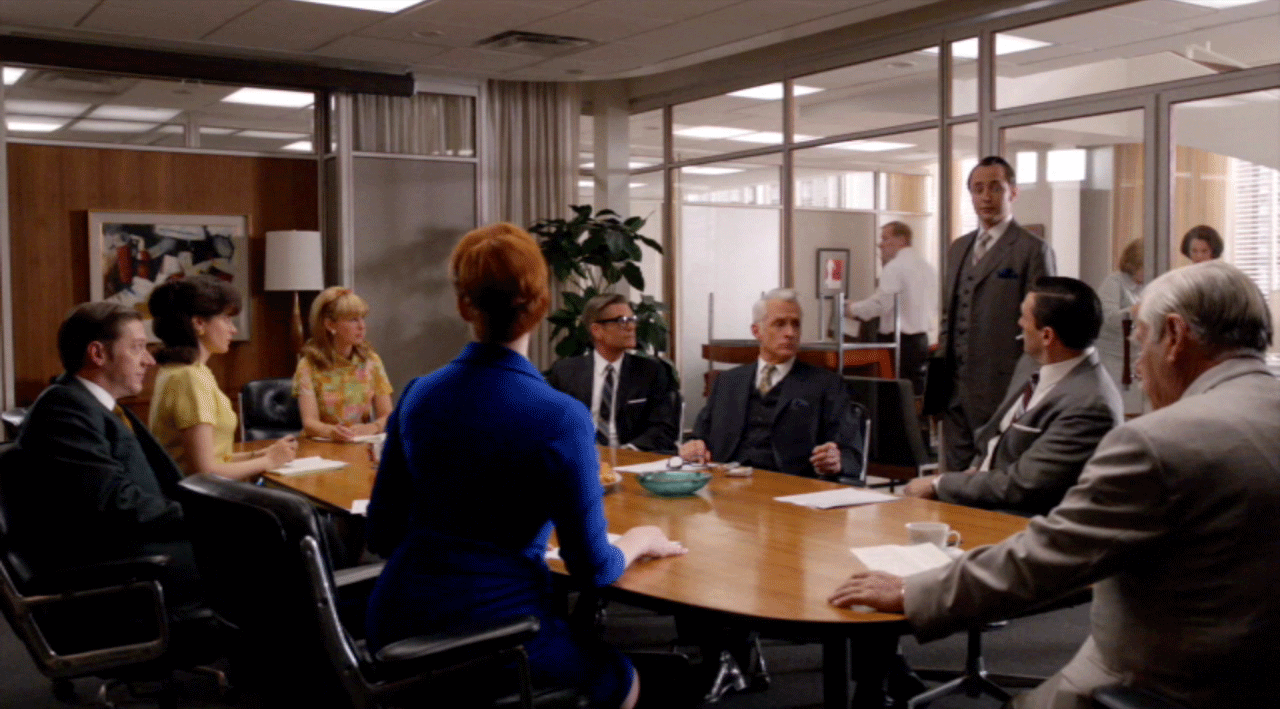 We have reached the doldrums. By this I do not mean some unexpected state of plot lethargy or ennui, since “Man with a Plan,” the seventh episode of Season 6, is full of hustle and bustle, and since 1968 is one of the least drowsy years in American history. Rather, I mean something structural, constitutional. I mean the seventh episode of what I have called the “sonnet season”*—that is, the 13-episode uninterrupted narrative unit inaugurated by The Sopranos in 1999, which has served as the template for much of the most prominent television of the 21st century.
We have reached the doldrums. By this I do not mean some unexpected state of plot lethargy or ennui, since “Man with a Plan,” the seventh episode of Season 6, is full of hustle and bustle, and since 1968 is one of the least drowsy years in American history. Rather, I mean something structural, constitutional. I mean the seventh episode of what I have called the “sonnet season”*—that is, the 13-episode uninterrupted narrative unit inaugurated by The Sopranos in 1999, which has served as the template for much of the most prominent television of the 21st century. The sonnet season has transformed not just how television is made but how television is discussed. It is a season that is more compact, more distinct than the typical network sprawl of 20-plus installments (or 39, in the case of a 1960s show like the fictional Grin and Barrett conceived in Mad Men’s second season). But it is a season that has more space for development and alteration than the six or eight hours of the British televisual tradition, where the beginning and the end are in such proximate conversation as to allow no room for a real middle.
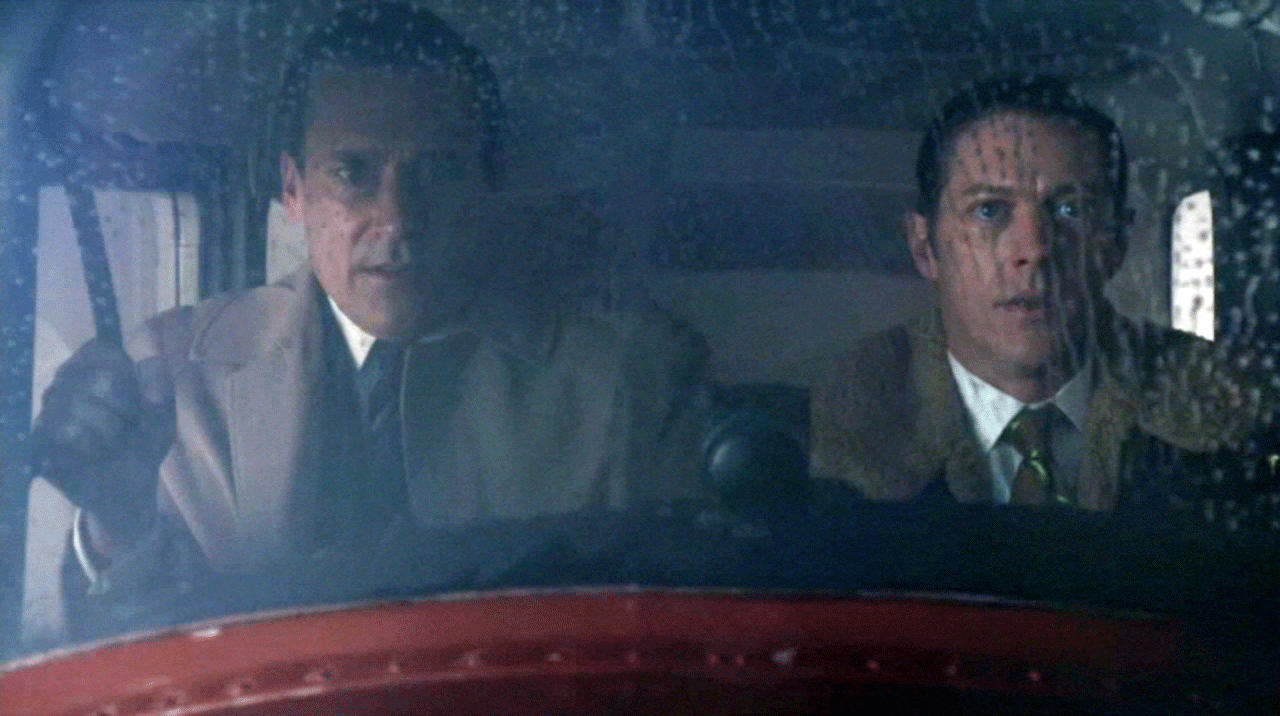 In the middle of such a season, at the juncture of the seventh episode, we are potentially neither here nor there; far enough from the beginning to feel launched, far enough from the end to feel the tidal pull of conclusion. We are—to cite the Oxford English Dictionary’s most targeted definition of “doldrums”—-in “the region of calms and light baffling winds near the equator, where the trade winds meet and neutralize each other.” The terms and directions of the season have been put in motion, but we do not yet understand, or need to understand, the eventual place where we will land. Or, to use Ted Chaough’s description of air travel: it is where we are once we have leveled off, having navigated the clouds of turbulent ascent. It’s our chance to take in the wonder of God’s televisual majesty.
In the middle of such a season, at the juncture of the seventh episode, we are potentially neither here nor there; far enough from the beginning to feel launched, far enough from the end to feel the tidal pull of conclusion. We are—to cite the Oxford English Dictionary’s most targeted definition of “doldrums”—-in “the region of calms and light baffling winds near the equator, where the trade winds meet and neutralize each other.” The terms and directions of the season have been put in motion, but we do not yet understand, or need to understand, the eventual place where we will land. Or, to use Ted Chaough’s description of air travel: it is where we are once we have leveled off, having navigated the clouds of turbulent ascent. It’s our chance to take in the wonder of God’s televisual majesty.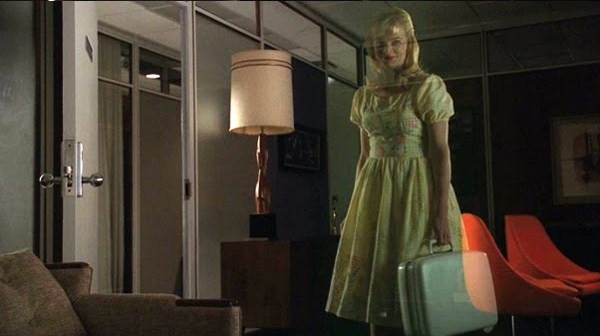 A seventh episode can emphasize its position as showstopper. See, for example, “The Suitcase,” everyone's favorite melodramatic two-hander. The midpoint of Mad Men’s fourth season operated explicitly as a break, a chance both to deploy a significant plot change—-the death of the original Mrs. Draper—-and to focus as intimately as the series ever has into the emotional particulars of the show's central relationship—-Don and Peggy. “The Suitcase” to some degree exists independently of its season's trade winds. Watching it, we may have sensed that everything had changed, suddenly—for Don and Peggy, for the show, for us. And yet in many ways nothing changed in the subsequent weeks, an illusory epiphany of the kind that featured so prominently in Mad Men’s ancestor series, The Sopranos. That simultaneous position of significant weight and significant weightlessness may perhaps be the privilege of an episode at the center of things.
A seventh episode can emphasize its position as showstopper. See, for example, “The Suitcase,” everyone's favorite melodramatic two-hander. The midpoint of Mad Men’s fourth season operated explicitly as a break, a chance both to deploy a significant plot change—-the death of the original Mrs. Draper—-and to focus as intimately as the series ever has into the emotional particulars of the show's central relationship—-Don and Peggy. “The Suitcase” to some degree exists independently of its season's trade winds. Watching it, we may have sensed that everything had changed, suddenly—for Don and Peggy, for the show, for us. And yet in many ways nothing changed in the subsequent weeks, an illusory epiphany of the kind that featured so prominently in Mad Men’s ancestor series, The Sopranos. That simultaneous position of significant weight and significant weightlessness may perhaps be the privilege of an episode at the center of things.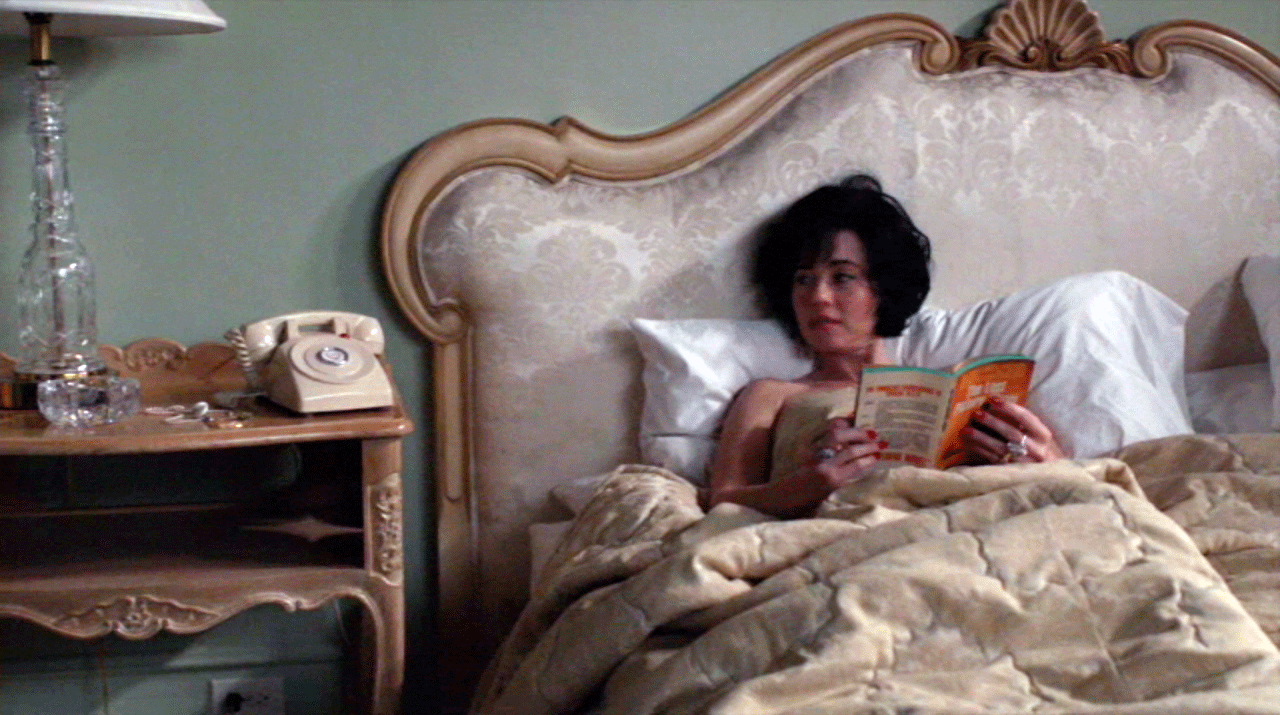 We get a version of that intimacy here in the Don and Sylvia story, in a room that they temporarily agree to seal off from the rest of the world. But their story has always been an opaque one for us, since their middle was our beginning, our introduction to her in the Season 6 premiere, “The Doorway” (covered in this series by Bruce Robbins) an instance of in medias res. With the exception of Midge Daniels at the very beginning of the series, we had been there at the start of every one of Don’s extramarital dalliances. His relationship with Sylvia, like the sixth season more generally, has made the relative position of beginning and middle harder to map out.
We get a version of that intimacy here in the Don and Sylvia story, in a room that they temporarily agree to seal off from the rest of the world. But their story has always been an opaque one for us, since their middle was our beginning, our introduction to her in the Season 6 premiere, “The Doorway” (covered in this series by Bruce Robbins) an instance of in medias res. With the exception of Midge Daniels at the very beginning of the series, we had been there at the start of every one of Don’s extramarital dalliances. His relationship with Sylvia, like the sixth season more generally, has made the relative position of beginning and middle harder to map out. 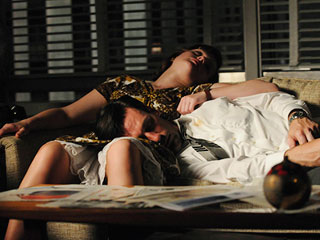 “The Suitcase” was the fruit of an intimacy gleaned slowly, week after week; its story was, to a large degree, the story of two people shedding their guardedness, their roles, and enacting some possible version of their true selves. By contrast, Don and Sylvia indulge in elaborate make-believe, in artifice rather than exposure. In this way, “Man with a Plan” is almost the obverse of “The Suitcase”; if the final word of the earlier episode was “open”—a gesture toward doorways that also inaugurated this season—the corresponding threshold, or more precisely elevator, would appear here to be “closed.” Don wants to linger in the middle, in the suspension of space marked by room 503 of the Sherry-Netherland Hotel. Sylvia, a narrative traditionalist, finally insists on going home, in that most ancient of narrative drives, a journey that may take her toward episode 13 of this season, or somewhere completely outside our orbit.
“The Suitcase” was the fruit of an intimacy gleaned slowly, week after week; its story was, to a large degree, the story of two people shedding their guardedness, their roles, and enacting some possible version of their true selves. By contrast, Don and Sylvia indulge in elaborate make-believe, in artifice rather than exposure. In this way, “Man with a Plan” is almost the obverse of “The Suitcase”; if the final word of the earlier episode was “open”—a gesture toward doorways that also inaugurated this season—the corresponding threshold, or more precisely elevator, would appear here to be “closed.” Don wants to linger in the middle, in the suspension of space marked by room 503 of the Sherry-Netherland Hotel. Sylvia, a narrative traditionalist, finally insists on going home, in that most ancient of narrative drives, a journey that may take her toward episode 13 of this season, or somewhere completely outside our orbit.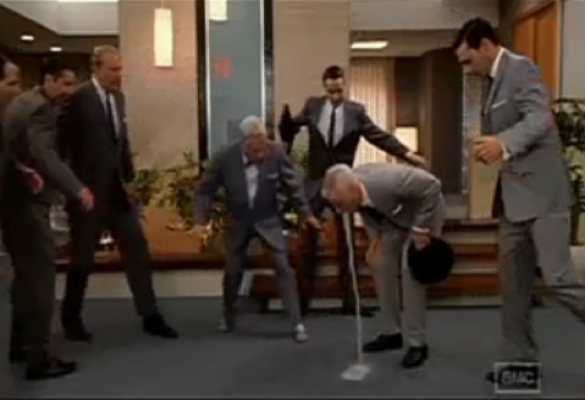 Not every seventh episode can, or should, be “The Suitcase.” In some ways, the series’ first seventh may represent the most archetypal illustration of the possibilities of the middle. You may or may not recall “Red in the Face,” from Mad Men’s inaugural campaign. Sandwiched between the series-defining “Babylon” and the back story explosion of “The Hobo Code,” “Red in the Face” is a sardonic sketch of marital and workplace tension, featuring Pete's saga of the Chip ‘n’ Dip and Don making Roger walk up 22 flights after an oyster-swollen lunch, in revenge for flirting with Betty. It ends with a barf and a smirk, and it is less tethered to the large serial movements of the season than the preceding or succeeding episodes. If “The Suitcase” is the seventh episode as deep burrowing, “Red in the Face” is the seventh episode as lateral move; it is the kind of episode we get if we think of the 13-episode season less as a novel and more as a collection of short stories, in the manner of Winesburg, Ohio (a copy of which sits in Dick Whitman’s tent in Korea). It is Mad Men as anthology show, as an array of simultaneous options in a narrative universe, rather than a necessarily sequential logic of cause and effect.
Not every seventh episode can, or should, be “The Suitcase.” In some ways, the series’ first seventh may represent the most archetypal illustration of the possibilities of the middle. You may or may not recall “Red in the Face,” from Mad Men’s inaugural campaign. Sandwiched between the series-defining “Babylon” and the back story explosion of “The Hobo Code,” “Red in the Face” is a sardonic sketch of marital and workplace tension, featuring Pete's saga of the Chip ‘n’ Dip and Don making Roger walk up 22 flights after an oyster-swollen lunch, in revenge for flirting with Betty. It ends with a barf and a smirk, and it is less tethered to the large serial movements of the season than the preceding or succeeding episodes. If “The Suitcase” is the seventh episode as deep burrowing, “Red in the Face” is the seventh episode as lateral move; it is the kind of episode we get if we think of the 13-episode season less as a novel and more as a collection of short stories, in the manner of Winesburg, Ohio (a copy of which sits in Dick Whitman’s tent in Korea). It is Mad Men as anthology show, as an array of simultaneous options in a narrative universe, rather than a necessarily sequential logic of cause and effect. 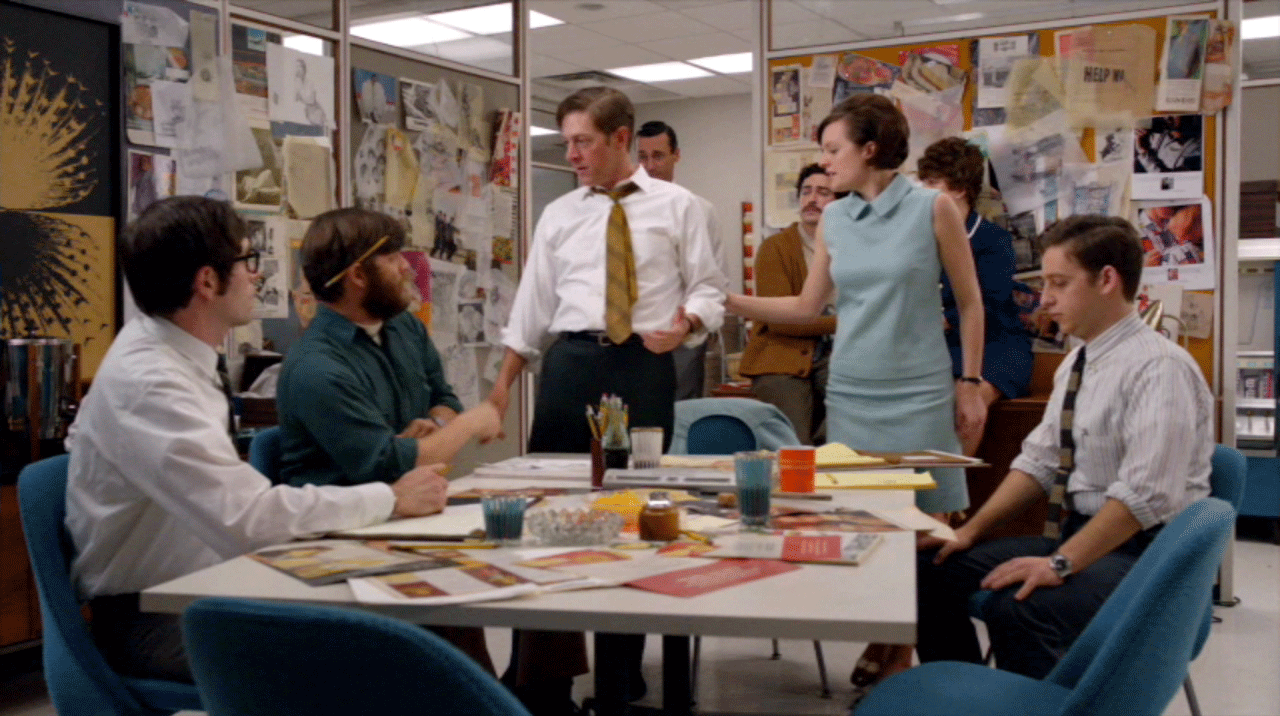 There is too much going on in “Man with a Plan” to be as light on its feet as Season 1’s “Red in the Face.” But we do get a compressed version of the earlier episode’s investment in alpha men as sex and alcohol performers. The improvised flirtation that Roger directs toward Betty in the Draper kitchen coagulates here into the domination ritual that Don concocts for Sylvia. More directly similar is Don’s attempt to dominate Ted by out-drinking him. Don’s most prominent man-with-a-plan gambit in season one was that well-designed revenge in “Red in the Face”: bribing the elevator operator (an occupation that Don must assume for himself at the start of this week’s episode) to pretend that the lift is out of service. Here, all he needs is a bottle of Canadian Club and a new business partner who doesn’t want to get left behind. Unlike that earlier episode, Don emerges from these games as vanquished, or at least chastised, rather than merrily triumphant. “Move forward,” Peggy admonishes him, anticipating Sylvia’s demand that they leave the doldrums.
There is too much going on in “Man with a Plan” to be as light on its feet as Season 1’s “Red in the Face.” But we do get a compressed version of the earlier episode’s investment in alpha men as sex and alcohol performers. The improvised flirtation that Roger directs toward Betty in the Draper kitchen coagulates here into the domination ritual that Don concocts for Sylvia. More directly similar is Don’s attempt to dominate Ted by out-drinking him. Don’s most prominent man-with-a-plan gambit in season one was that well-designed revenge in “Red in the Face”: bribing the elevator operator (an occupation that Don must assume for himself at the start of this week’s episode) to pretend that the lift is out of service. Here, all he needs is a bottle of Canadian Club and a new business partner who doesn’t want to get left behind. Unlike that earlier episode, Don emerges from these games as vanquished, or at least chastised, rather than merrily triumphant. “Move forward,” Peggy admonishes him, anticipating Sylvia’s demand that they leave the doldrums. One thing that both episodes clearly share is a moment of throwing up. Indeed, prominent scenes of vomiting—-or preparation for the same—-occur in no fewer than four of Mad Men’s seventh episodes. This may be coincidental; but I choose to think of the phenomenon as a self-conscious recognition that seventh episodes may be necessary emetics, places to purge before we binge on the second half of the season.** In this instance we get Joan’s dry heaves, whose primary purpose appears to be to bring Bob Benson from recurrent, inscrutable background to something like front and center. I have thought of him throughout this season as something like the man in the macintosh in Ulysses-—the most minor of characters, who pops up here and there with no ostensible purpose or consequence, beyond the purpose of inscribing minorness as an interest of the narrative. Unless we are being aggressively misled, the prognosis for Joan’s ovarian cyst certainly seems better than the one for Frank Gleason’s pancreatic cancer. Why is this minor excursion here at all? This seems a deliberate design to move the storyline of Bob Benson—-prominently wearing a macintosh here—-from the edge to the center, mirroring to some degree the collision of peripheral and dominant characters in the chaotic hallways of the still-unnamed agency that Don and Ted created in Detroit.
One thing that both episodes clearly share is a moment of throwing up. Indeed, prominent scenes of vomiting—-or preparation for the same—-occur in no fewer than four of Mad Men’s seventh episodes. This may be coincidental; but I choose to think of the phenomenon as a self-conscious recognition that seventh episodes may be necessary emetics, places to purge before we binge on the second half of the season.** In this instance we get Joan’s dry heaves, whose primary purpose appears to be to bring Bob Benson from recurrent, inscrutable background to something like front and center. I have thought of him throughout this season as something like the man in the macintosh in Ulysses-—the most minor of characters, who pops up here and there with no ostensible purpose or consequence, beyond the purpose of inscribing minorness as an interest of the narrative. Unless we are being aggressively misled, the prognosis for Joan’s ovarian cyst certainly seems better than the one for Frank Gleason’s pancreatic cancer. Why is this minor excursion here at all? This seems a deliberate design to move the storyline of Bob Benson—-prominently wearing a macintosh here—-from the edge to the center, mirroring to some degree the collision of peripheral and dominant characters in the chaotic hallways of the still-unnamed agency that Don and Ted created in Detroit.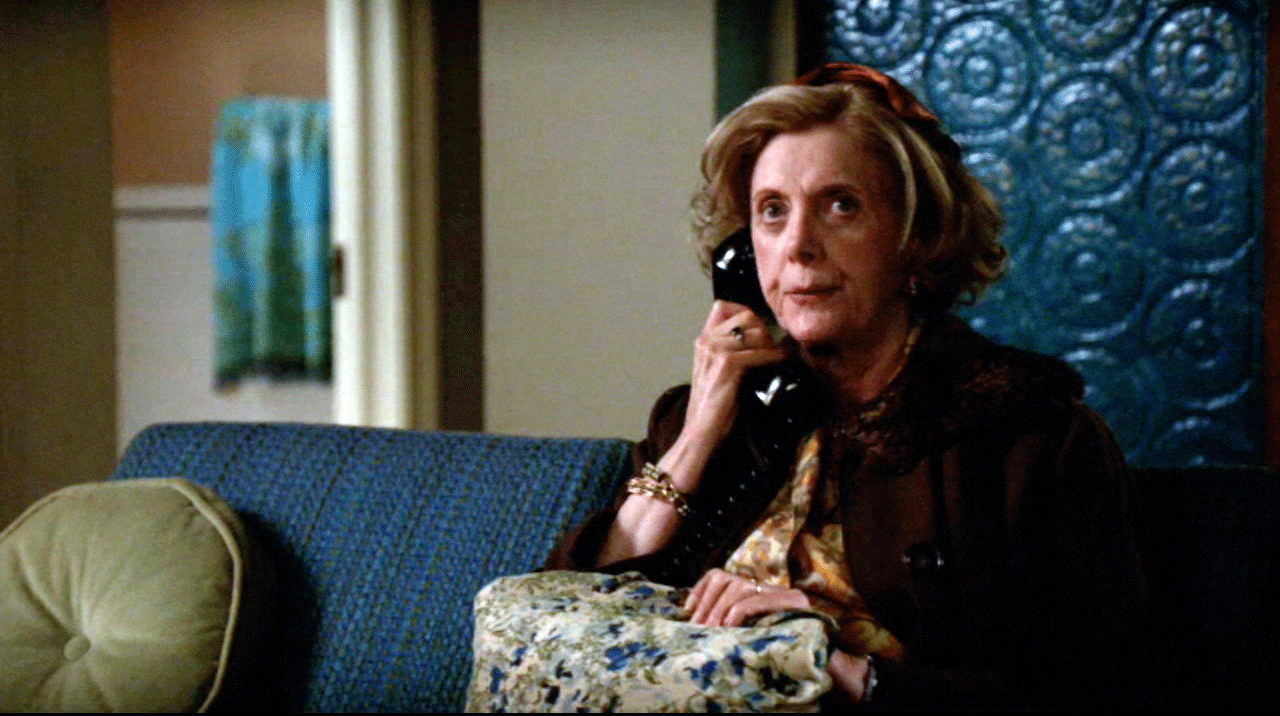 There is no escaping the clash of beginning, middle, and end throughout the episode. It’s the first day of school, Ted tells Peggy, and we catch Bert Cooper in the middle of an announcement about the merger, but with no ending scripted yet. (Not to worry; they’ve got a lot of writers out there.) “Were in the middle of a merger,” Pete exclaims to his brother, even as his mother appears to be nearing her end. It’s worth recalling that the seventh episode of the third season, “Seven Twenty Three,” also marked a new business arrangement; at the behest of Conrad Hilton, Don Draper finally signed a contract with Sterling Cooper. We all remember how well that turned out. So the middle-as-beginning inversion is hardly a new one—as forecast by the very beginning of the season, where we found ourselves in a dark wood, in the middle of our life’s journey. The Inferno proved foundational for the season in more ways than one: Dante’s invented verse of terza rima is the most serial of poetic schemes, since each three-line segment explicitly triggers its successor. The aba bcb cdc ded structure, where the middle rhyme in one triad always becomes the beginning and end rhymes of the next triad, inscribes an interdependence of origin, center, and conclusion. (The rich relationships between epic and serial are the least examined branches in narrative genealogy.)
There is no escaping the clash of beginning, middle, and end throughout the episode. It’s the first day of school, Ted tells Peggy, and we catch Bert Cooper in the middle of an announcement about the merger, but with no ending scripted yet. (Not to worry; they’ve got a lot of writers out there.) “Were in the middle of a merger,” Pete exclaims to his brother, even as his mother appears to be nearing her end. It’s worth recalling that the seventh episode of the third season, “Seven Twenty Three,” also marked a new business arrangement; at the behest of Conrad Hilton, Don Draper finally signed a contract with Sterling Cooper. We all remember how well that turned out. So the middle-as-beginning inversion is hardly a new one—as forecast by the very beginning of the season, where we found ourselves in a dark wood, in the middle of our life’s journey. The Inferno proved foundational for the season in more ways than one: Dante’s invented verse of terza rima is the most serial of poetic schemes, since each three-line segment explicitly triggers its successor. The aba bcb cdc ded structure, where the middle rhyme in one triad always becomes the beginning and end rhymes of the next triad, inscribes an interdependence of origin, center, and conclusion. (The rich relationships between epic and serial are the least examined branches in narrative genealogy.)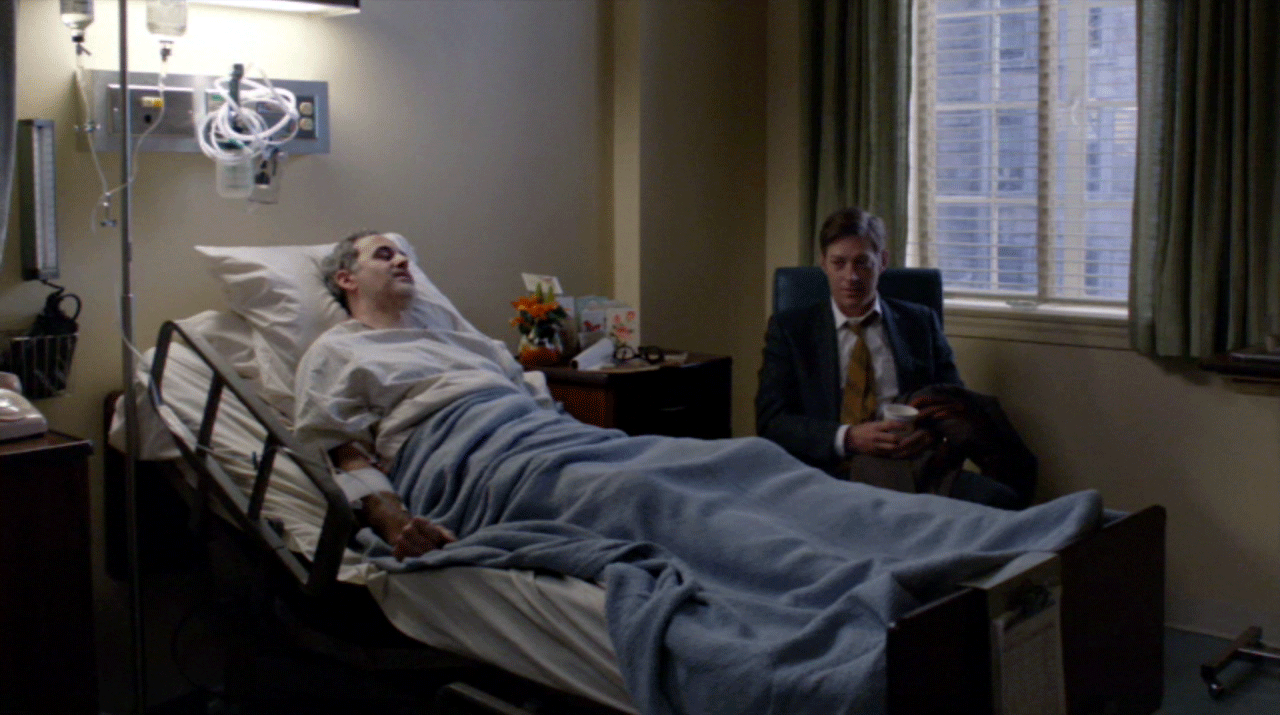 Perhaps my favorite scene in “Man with a Plan” has less to do, ostensibly, with matters of form; but it’s certainly about issues of limitations, and about the sense of closure that we think we can sniff in a seventh episode. It’s the hospital conversation between Ted Chaough and Frank Gleason—-the second of three hospitals in the episode, following Joan’s encounter with Nurse Finnegan (more James Joyce?) and preceding Bobby Kennedy’s transportation to the Good Samaritan in Los Angeles. This scene may be Mad Men at its best. Here’s one character who until recently has existed more or less in the zone of caricature, as the prankster and provocateur rather than the complicated nemesis; and another character whose existence did not even register until last week, a character whose beginning for us is an end for him. We dip into a relationship that has clearly evolved for decades; these are characters that have existed, in their own drama, outside the selective focalization of Sterling Cooper and its successors. Mixed with the soapiness of introducing a character on what appears to be his deathbed, we also get a prominent maneuver of the realist tradition—-the sudden immersion in a world that exists independently of us, of what we think we need to know. We get banter between two men that is the froth of many days, weeks, years of association, the reminder of what was and the speculation about what might be. There may be a whiff of Tony Soprano’s vigil for the cancer-stricken Jackie Aprile, in the early days of that series, when a sidekick in a crime family suddenly had to become a protagonist. Ted Chaough may not have been a sidekick within the world of CGC, but he has certainly been a sidekick in the world of Mad Men. As Alex Woloch has argued, major characters in realist fiction always exist dynamically with minor characters, creating space for themselves at the expense of others who threaten to take their place. For Ted to become important to the narrative with which we’re familiar, Gleason’s minorness must be recorded, and then his character jettisoned. There are only so many chairs to go around.
Perhaps my favorite scene in “Man with a Plan” has less to do, ostensibly, with matters of form; but it’s certainly about issues of limitations, and about the sense of closure that we think we can sniff in a seventh episode. It’s the hospital conversation between Ted Chaough and Frank Gleason—-the second of three hospitals in the episode, following Joan’s encounter with Nurse Finnegan (more James Joyce?) and preceding Bobby Kennedy’s transportation to the Good Samaritan in Los Angeles. This scene may be Mad Men at its best. Here’s one character who until recently has existed more or less in the zone of caricature, as the prankster and provocateur rather than the complicated nemesis; and another character whose existence did not even register until last week, a character whose beginning for us is an end for him. We dip into a relationship that has clearly evolved for decades; these are characters that have existed, in their own drama, outside the selective focalization of Sterling Cooper and its successors. Mixed with the soapiness of introducing a character on what appears to be his deathbed, we also get a prominent maneuver of the realist tradition—-the sudden immersion in a world that exists independently of us, of what we think we need to know. We get banter between two men that is the froth of many days, weeks, years of association, the reminder of what was and the speculation about what might be. There may be a whiff of Tony Soprano’s vigil for the cancer-stricken Jackie Aprile, in the early days of that series, when a sidekick in a crime family suddenly had to become a protagonist. Ted Chaough may not have been a sidekick within the world of CGC, but he has certainly been a sidekick in the world of Mad Men. As Alex Woloch has argued, major characters in realist fiction always exist dynamically with minor characters, creating space for themselves at the expense of others who threaten to take their place. For Ted to become important to the narrative with which we’re familiar, Gleason’s minorness must be recorded, and then his character jettisoned. There are only so many chairs to go around.*Kritik will soon be providing access to this piece on the Unit for Criticism's webpage.
** For those scoring at home, those four episodes are “Red in the Face,” “The Gold Violin,” “The Suitcase,” and “Man with a Plan.” And Sally Draper certainly felt like throwing up when she saw what she saw at the codfish ball.